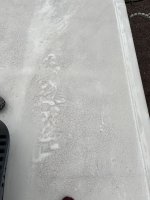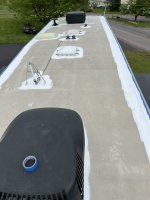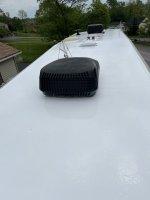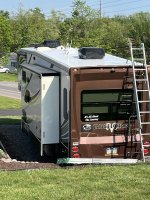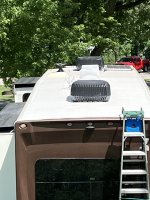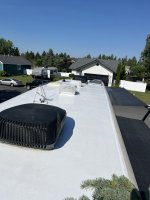travelin2
Pennsylvania Chapter Leaders-retired
As owners of a BH built in 2016, we too have succumbed to the sticky gooey roof debacle.
Last year after spending the winter in Texas I figured the roof was due for a washing to remove the dust and pollen. While doing so I noticed several imprints of my shoe sole in the rubber membrane thinking “that’s not good”. Later when I was replacing the failed TV antenna, I noticed how easy it was to scuff up the roof.
I had seen posts on various RV forums of others who experienced similar issues but, like others I presume, felt that wouldn’t happen to us. Well, now I knew for sure we had joined the “sticky roof club”!
I attempted to seal it with some RV roof protectant to no avail. The roof just became even more sticky. This past winter’s stay in Texas proved I had to do something. The roof collected so much dust & dirt it was almost chocolate brown and a normal scrubbing removed little of the filth.
So the research began for a solution I could afford on an 8 year old camper that we do not intend to keep another 8 years!
I called Dicor and they, being aware of the problem, explained that it was only the top coat that had failed and the under substrate was still intact and insisted the roof wouldn’t leak. Fine. But obviously the roof would continue to accumulate dust and dirt and increase the chances for mold and mildew. Plus the darker the roof the more heat it absorbs. Dicor was willing to ship me a new TPO roof kit however it would have cost me several thousand dollars for installation so I passed.
My solution…after more google searches, reading RV forums and product reviews, I settled on this in May
887 Tropi-Cool® 100% Silicone Roof Coating - Waterproof | Henry Company
and so far so good.
We’ve just completed a 6K mile cross country round trip where I had visions of it peeling off as we drove down the road, LOL!! That didn’t happen. During the trip we experienced some heavy thunderstorms and many days of excessive heat. It’s still super bright white, after a cleaning with a mild soap and lots of water, which I believe that attribute certainly reduces the interior temperature of the camper during the day. Now that we’re home again I’m seriously considering coating the top half of the AC cowlings to reduce heat there as well.
I have probably 14-15 man hours and approximately $500 invested.
The hardest part was cleaning the original membrane to remove the accumulated dirt and grime per the product’s instructions. It was an on your hands and knees job with a stiff scrub brush cleaning a small section at a time. I brushed it off a second time with a soft long handled brush and clean water. After it dried completely I cut in all the edges and around the items on the roof. I then rolled on two coats, each a day apart, using about 4 gallons total. Even though the product is more economical by the 5 gallon bucket I purchased the gallon size, obviously much easier to manage on the roof. Additionally the coating begins to cure quite quickly when exposed to the atmosphere so once started speed is of the essence as noted in most online reviews.
I am not endorsing or recommending that this is the cure all or the only solution, it’s just the one I chose.
I know this post is lengthy but I wanted to provide some background and context to the topic instead of just “I did this to my roof”.
Last year after spending the winter in Texas I figured the roof was due for a washing to remove the dust and pollen. While doing so I noticed several imprints of my shoe sole in the rubber membrane thinking “that’s not good”. Later when I was replacing the failed TV antenna, I noticed how easy it was to scuff up the roof.
I had seen posts on various RV forums of others who experienced similar issues but, like others I presume, felt that wouldn’t happen to us. Well, now I knew for sure we had joined the “sticky roof club”!
I attempted to seal it with some RV roof protectant to no avail. The roof just became even more sticky. This past winter’s stay in Texas proved I had to do something. The roof collected so much dust & dirt it was almost chocolate brown and a normal scrubbing removed little of the filth.
So the research began for a solution I could afford on an 8 year old camper that we do not intend to keep another 8 years!
I called Dicor and they, being aware of the problem, explained that it was only the top coat that had failed and the under substrate was still intact and insisted the roof wouldn’t leak. Fine. But obviously the roof would continue to accumulate dust and dirt and increase the chances for mold and mildew. Plus the darker the roof the more heat it absorbs. Dicor was willing to ship me a new TPO roof kit however it would have cost me several thousand dollars for installation so I passed.
My solution…after more google searches, reading RV forums and product reviews, I settled on this in May
887 Tropi-Cool® 100% Silicone Roof Coating - Waterproof | Henry Company
and so far so good.
We’ve just completed a 6K mile cross country round trip where I had visions of it peeling off as we drove down the road, LOL!! That didn’t happen. During the trip we experienced some heavy thunderstorms and many days of excessive heat. It’s still super bright white, after a cleaning with a mild soap and lots of water, which I believe that attribute certainly reduces the interior temperature of the camper during the day. Now that we’re home again I’m seriously considering coating the top half of the AC cowlings to reduce heat there as well.
I have probably 14-15 man hours and approximately $500 invested.
The hardest part was cleaning the original membrane to remove the accumulated dirt and grime per the product’s instructions. It was an on your hands and knees job with a stiff scrub brush cleaning a small section at a time. I brushed it off a second time with a soft long handled brush and clean water. After it dried completely I cut in all the edges and around the items on the roof. I then rolled on two coats, each a day apart, using about 4 gallons total. Even though the product is more economical by the 5 gallon bucket I purchased the gallon size, obviously much easier to manage on the roof. Additionally the coating begins to cure quite quickly when exposed to the atmosphere so once started speed is of the essence as noted in most online reviews.
I am not endorsing or recommending that this is the cure all or the only solution, it’s just the one I chose.
I know this post is lengthy but I wanted to provide some background and context to the topic instead of just “I did this to my roof”.

